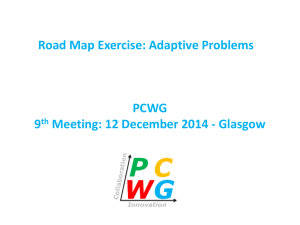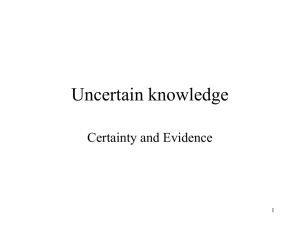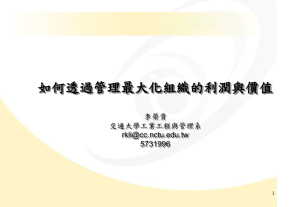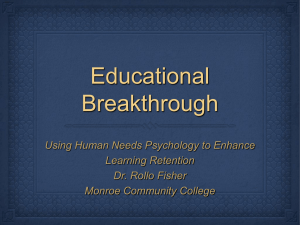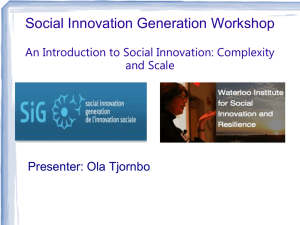Emotion in Isolation: Crossing Valence with Certainty Leads to
advertisement
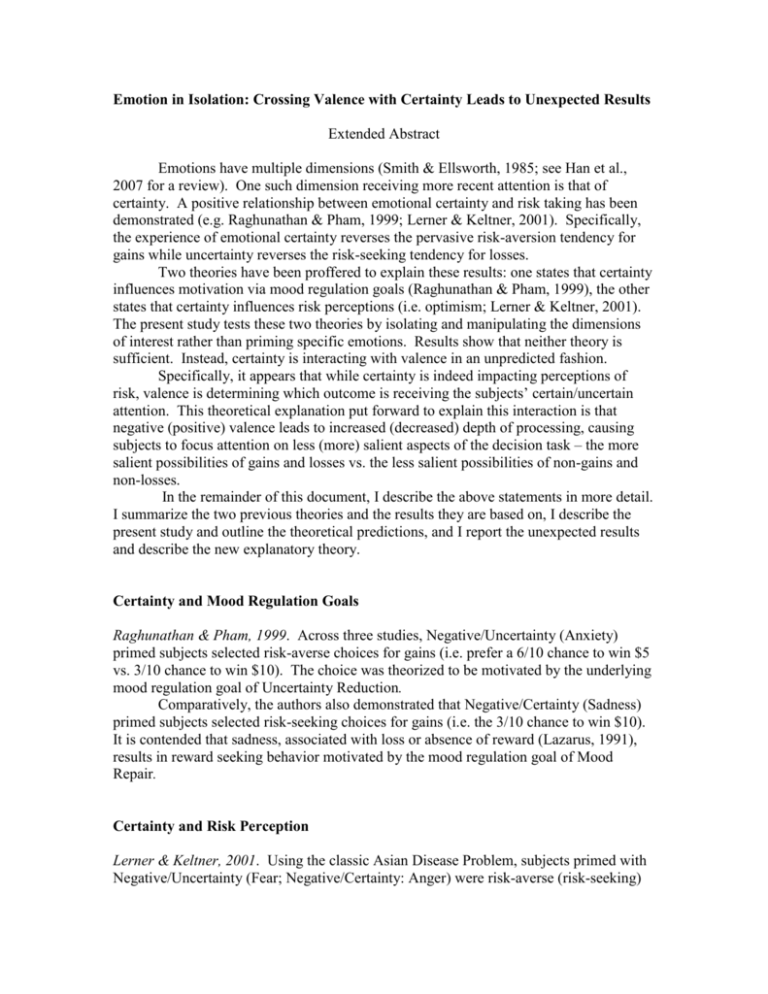
Emotion in Isolation: Crossing Valence with Certainty Leads to Unexpected Results Extended Abstract Emotions have multiple dimensions (Smith & Ellsworth, 1985; see Han et al., 2007 for a review). One such dimension receiving more recent attention is that of certainty. A positive relationship between emotional certainty and risk taking has been demonstrated (e.g. Raghunathan & Pham, 1999; Lerner & Keltner, 2001). Specifically, the experience of emotional certainty reverses the pervasive risk-aversion tendency for gains while uncertainty reverses the risk-seeking tendency for losses. Two theories have been proffered to explain these results: one states that certainty influences motivation via mood regulation goals (Raghunathan & Pham, 1999), the other states that certainty influences risk perceptions (i.e. optimism; Lerner & Keltner, 2001). The present study tests these two theories by isolating and manipulating the dimensions of interest rather than priming specific emotions. Results show that neither theory is sufficient. Instead, certainty is interacting with valence in an unpredicted fashion. Specifically, it appears that while certainty is indeed impacting perceptions of risk, valence is determining which outcome is receiving the subjects’ certain/uncertain attention. This theoretical explanation put forward to explain this interaction is that negative (positive) valence leads to increased (decreased) depth of processing, causing subjects to focus attention on less (more) salient aspects of the decision task – the more salient possibilities of gains and losses vs. the less salient possibilities of non-gains and non-losses. In the remainder of this document, I describe the above statements in more detail. I summarize the two previous theories and the results they are based on, I describe the present study and outline the theoretical predictions, and I report the unexpected results and describe the new explanatory theory. Certainty and Mood Regulation Goals Raghunathan & Pham, 1999. Across three studies, Negative/Uncertainty (Anxiety) primed subjects selected risk-averse choices for gains (i.e. prefer a 6/10 chance to win $5 vs. 3/10 chance to win $10). The choice was theorized to be motivated by the underlying mood regulation goal of Uncertainty Reduction. Comparatively, the authors also demonstrated that Negative/Certainty (Sadness) primed subjects selected risk-seeking choices for gains (i.e. the 3/10 chance to win $10). It is contended that sadness, associated with loss or absence of reward (Lazarus, 1991), results in reward seeking behavior motivated by the mood regulation goal of Mood Repair. Certainty and Risk Perception Lerner & Keltner, 2001. Using the classic Asian Disease Problem, subjects primed with Negative/Uncertainty (Fear; Negative/Certainty: Anger) were risk-averse (risk-seeking) across choices framed as gains as well as choices framed as losses, preferring the sure (risky) gain and the sure (risky) loss. The explanation was that the sense of uncertainty (certainty) associated with fear (anger) leads to perceptions of high (low) risk (i.e. pessimism/optimism). This in turn causes subjects to focus on worst (best) case scenarios and prefer the riskless (risky) options. To support their theory, the authors showed in a separate study that increased certainty led to increased optimism The Present Study and Predictions Is the certainty dimension impacting perceptions of risk or is it impacting mood regulation goals? In our study, we simply crossed valence by certainty in a 2 (positive/negative) by 2 (certain/uncertain) between subjects design. Rather than cloud the results by using specific emotions with varying underlying dimensional properties, we isolated the dimensions of interest by directly manipulated emotional certainty and valence themselves. For example, we asked subjects to describe in detail an emotional event in which they felt extremely negative and uncertain. We then administered the ‘Financial Decision Making’ task as an onstensible filler task before a manipulation check, suspicion probe, and demographics questions completed the study. The decision task was similar to Raghunathan and Pham (1999), e.g. 60% chance to win (lose) $5 vs. 30% chance to win (lose) $10. Both the ‘mood regulation goals’ theory and the ‘risk perceptions’ theory would predict that negative/certainty (vs. negative/uncertainty) leads to increased risk taking for losses and gains. However, they have differing predictions for positive emotions. Specifically, due to ‘mood maintenance’ goals, mood regulation theory would predict that positive/certainty (vs. positive/uncertainty) would lead to decreased risk-taking for gains and increased risk-taking for losses. Risk perception theory would predict no difference between gains and losses – that positive/certainty leads to increased risk-taking for both. Results and Discussion Gains. Subjects in the positive/certain (vs. positive/uncertain) were more risk-seeking, choosing the 30% $10 gain more often than the 60% $5 gain. Subjects in the negative condition were the exact opposite. Negative/certain (vs. negative/uncertain) were less risk seeking. Losses. Subjects in the negative/certain (vs. negative/uncertain) were more riskseeking, choosing the 30% $10 loss over the 60% $5 loss. The positive-valence subjects were the opposite: positive/certain (vs. positive/uncertain) subjects were less risk seeking . These actual results supported neither the Mood Regulation Theory nor the Risk Perceptions Theory as conceptualized by previous research. However, the results are consistent with a new theoretical framework wherein depth of processing interacts with risk perceptions. This interaction is further described below. I manipulated 2 dimensions that have been shown to impact both content of processing and depth of processing. The content of processing argument is what I sought to test: do these dimensions affect content via Mood Regulation Theory or Risk Perceptions Theory? However, it is possible that I actually influenced depth of processing as well as content, and results show that the two interact. Results suggest that certainty simply influenced cognition in a manner consistent with risk perceptions theory: subjects who felt more certain perceived ‘unlikely’ events as more likely. However, the events on which subjects directed this certain/uncertain attention seemed to be moderated by the depth of processing caused by valence (see Schwarz, Bless, and Bohner, 1991 for a review on valence and processing). Results suggest that subjects in the positive valence conditions attended more to surface cues (i.e. heuristic processing) while those in negative valence conditions attended to information implied but not overtly highlighted (i.e. systematic processing). Specifically, subjects in positive valence conditions focused their attention on the highlighted possibilities of gains and losses while subjects in the negative valence conditions attended to the implied possibilities of non-gains and non-losses. REFERENCES

